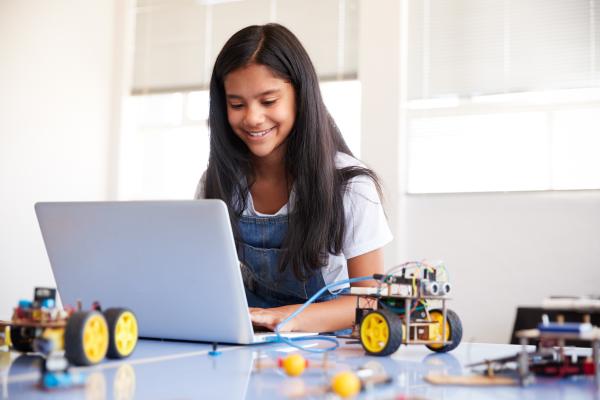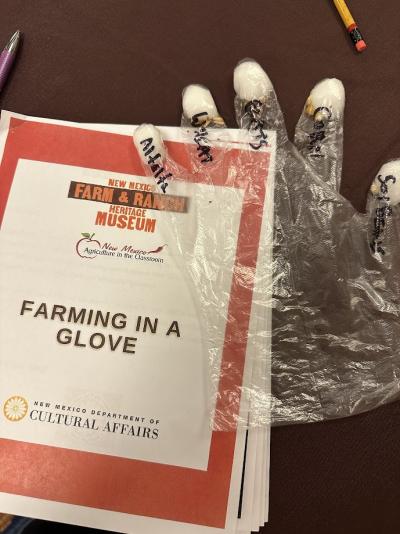Picture this: a hotel meeting room with, not your typical podium and speaker, but tables of librarians playing with…dirt and plastic gloves? Upon closer inspection, it’s not dirt, but adobe mud, and those plastic gloves are full of tiny seeds. Why? These librarians are participating in hands-on STEAM (Science, Technology, Engineering, Arts, Math) activities so they can take home fun new program ideas.
Thinking Outside the (STEAM) Box: Bringing the Library to Your Community Using Kits was a program held at the 2024 ALA Annual Conference in San Diego. In collaboration with the STAR Library Network and the Emmy award-winning SciGirls television show, this session offered strategies for library workers to create inclusive and engaging STEAM programs for tweens and their families, with an emphasis on gender inclusivity and cultural responsiveness.
Speakers discussed the best approaches for creating hands-on STEAM activities while participants got to speak to their own success stories. Here are some key takeaways from the session.

Bust the myth of being a “science person”
When creating STEAM kits and activities for tweens, it’s important to know that most tweens will already see themselves as a “science person” or “not a science person.” The tween years are pivotal in making that recognition, especially since young people’s views of themselves are often impacted during this time by disparities in popular representation of women and people of color working in STEAM careers. Libraries can provide unique opportunities to make STEAM interesting and accessible for everyone, “science person” or not.
Use your community as inspiration for outreach kit creation
As part of ALA’s STAR Net STEAM Equity Project, participating libraries in rural communities received STEAM resources and exhibits to help develop their own exploration pathways such as exploration spaces, learning programs and outreach kits.
“It can be overwhelming to begin STEAM outreach,” says Miguel Ruiz, supervising librarian at Arlington Public Library in Virginia and STEAM Equity Project advisor. “Ask yourself: who from the community am I not reaching? And use an equity lens while creating community-specific programming.” Outreach kits can be an important collaborative effort with local community partners and a useful way to reach tween populations outside of the library.
Outreach kits can be brought to community partner organizations as a hands-on program outside of the library or can be circulated for checkout. Kits can consist of items and activities the library already has on hand as well as off-the-shelf STEAM education products like Ozobots or Snap Circuits.
Kits can also be a unique way to engage your library’s teen volunteers. Have teen volunteers oversee outreach kit activities and let them have a hand in creating STEAM programs for younger kids and tweens. Just make sure you know how to work items in the kit before letting the teens take over any instruction!
Rebekah Lynam, branch manager of Purcell Public Library in Oklahoma, says to focus on kit activities that work for your community. As part of Lynam’s STEAM Equity grant, her library created STEAM kits focused on biology, robotics and engineering. “Purcell is a rural area known as the Quarter Horse Capital of the World,” Lynam says. “When we were brainstorming STEAM ideas, incorporating horses into the biology kits was a no-brainer.”

Some other things to consider when creating a STEAM outreach kit include:
- Who is your audience?
- What is your theme?
- Which hands-on activity(ies) do you want to add?
- Do you want to add books? What books?
- Do you want to add educational tools?
- What support materials do you need? Are they culturally relevant based off your audience?
6 ways to engage tween girls in STEAM
A large component of the session revolved around engaging, not just the tween demographic, but tween girls specifically. Niki Beverly, project manager at Twin Cities PBS, says that “media and education change how girls see STEAM and how the world sees girls.” The SciGirls show on PBS uses a three-pronged approach to engaging young girls: television and online and in-person activities.
Beverly shared key strategies from SciGirls that can make STEAM education supportive and enlightening for all.
- Connect STEM experience to girls’ lives. “Create experiences that allow girls to explore issues or topics they care about and that impact their lives,” Beverly says. “This will help girls see the relevancy of STEM.”
- Support girls as they investigate questions and solve problems using STEM practices.
- Empower girls to embrace struggle, overcome challenges and increase self-confidence in STEM. “Teach girls that working through problems and having experiments fail is a normal part of the scientific and engineering process,” says Beverly.
- Encourage girls to identify and challenge STEM stereotypes.
- Emphasize that STEM is collaborative, social and community oriented.
- Provide opportunities for girls to interact with and learn from diverse STEM role models. “Invite role models to be guest speakers,” says Beverly. “Host a ‘Women in STEM’ panel and provide opportunities for girls to engage in hands-on activities with role models."
Educate yourself on tween development
ALA’s STAR Net STEAM Equity Project reached libraries in rural communities that serve significant Hispanic/Latino populations. One of the project’s aims was to engage Latina tweens through culturally relevant programs. Veronica Casanova, STEAM Equity Project advisor and librarian at Tulare County Library in California, presented on how library staff can support Latina tweens (and all tween library visitors) through a developmental lens.
“Physical growth does not equal emotional development,” Casanova says. While creating STEAM programs, remember to keep the tween developmental stage in mind including emotional and social development — tweens are often sensitive and may begin to challenge authority.
To help support Latina tweens, Casanova says to build relationships with families. “Latina tweens understand that the library is a safe space,” she says. “They often will visit the library with their entire family and participate in programs as a family unit.”
Resources and kit activities

So, what did conference attendees think of their own hands-on experience with a STEAM kit? Flo Trujillo, president of REFORMA de Nuevo Mexico and STEAM Equity Project advisor, guided session participants through two STEAM kit activities: adobe brick making and Farming in a Glove. The activities were designed to teach natural and plant growth science recommended for kids and tweens, but in the San Diego meeting room, librarians enjoyed taking the time from back-to-back conference sessions to get their hands a bit dirty.
Along with the two hands-on activities, participants got to interact with library-friendly robots including Bee-Bots, Joystick and Cubelets.
Additional resources shared include:
- StarNet Libraries STEM Activity Clearing House
- SciGirl activities and videos
- Printable Bilingual STEAM Activity Cards
- STEAM Role Models Posters and Trading Cards
- National Agriculture in the Classroom
Recommended off-the-shelf STEAM education products:



